How Do I Know If I Have Mold In My Crawl Space?
Mold often presents itself as a musty, earthy odor that can permeate your entire home, or as visible patches of discoloration on wood and other surfaces. These patches can be black, green, or white and may have a fuzzy or slimy texture. If you suspect mold, especially in a humid climate where crawl space encapsulation in SC or GA is crucial, it's vital to get a professional inspection. Mold can pose health risks and compromise the structural integrity of your home, so accurate identification and safe removal are essential. Our experts are trained to handle this safely and effectively.
How Do I Know If I Have Moisture Problems In My Crawl Space?
Common signs of moisture issues include damp soil, condensation on pipes, and warped or buckling wooden floors above the crawl space. You might also notice a significant increase in humidity inside your home, which can feel heavy and uncomfortable. Pest infestations, like termites, often thrive in moist environments. Addressing these problems early is vital to prevent more serious damage, such as wood rot or structural failure. We offer free moisture inspections to accurately diagnose the problem and recommend a lasting solution.
Why Is There Water In My Ductwork?
Water in your ductwork is typically a sign of high humidity levels and temperature imbalances, often originating from a compromised crawl space. When warm, humid air from the crawl space meets the cold surfaces of your air ducts, condensation forms. This can lead to rust, mold growth inside the ducts, and poor indoor air quality. Without a proper solution, this issue can cause significant damage and even lead to health concerns. Our team can help solve this issue at its source through professional crawl space encapsulation in GA or SC.
Why Are My Floors Cold?
Cold floors are often a direct result of poor insulation or high humidity in the crawl space, which allows cold air to rise into your home. This process, known as the "stack effect," can make your living spaces uncomfortable and lead to higher heating bills. A properly encapsulated crawl space acts as a thermal barrier, sealing and insulating the area. This helps maintain a more consistent temperature, making your floors warmer, improving your home's energy efficiency, and creating a more comfortable living environment for you and your family.
What Is A French Drain?
A French drain is a trench containing a perforated pipe surrounded by gravel, designed to collect and divert water away from your home's foundation. This is a crucial component of a comprehensive water management system, especially for homes that experience persistent flooding or water accumulation around the foundation. The drain effectively channels surface water and groundwater away from the crawl space, reducing hydrostatic pressure on the foundation walls and preventing water from entering the area.
What Is A Crawl Space Encapsulation?
Crawl space encapsulation is the process of sealing your entire crawl space with a heavy-duty vapor barrier, insulation, and a high-efficiency dehumidifier. This creates a dry, conditioned environment, completely separating the area from the outside elements. It prevents moisture, mold, and pest problems while improving air quality and energy efficiency. It is the gold standard for protecting your home’s foundation and structural integrity. Whether you are in Georgia or South Carolina, our crawl space encapsulation SC and crawl space encapsulation GA services are designed to meet the specific needs of your home and climate. Call us today to learn more about the benefits!
What To Do If I Find Water In My Crawl Space?
If you find standing water in your crawl space, the first step is to identify the source. It could be due to a plumbing leak, foundation cracks, or poor exterior drainage. Regardless of the cause, it is important to call professionals immediately to assess the situation. Delaying action can lead to mold growth, wood rot, and expensive structural damage. We can help you with a comprehensive plan to mitigate the water damage, address the source of the problem, and implement a long-term solution to prevent future occurrences.


